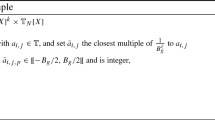Abstract
This paper is concerned with the security level expected by the canonical form of the self-synchronizing stream cipher (SSSC). A SSSC can be viewed as the combination of a shift register together with a filtering function. The maximum security of such a cipher is reached when the filtering function is random. However, in practice, pseudo random functions are used as filtering functions. In this case, we show that the security against chosen ciphertext attacks (IND-CCA security) cannot be reached but it is however secure against chosen plaintext attacks (IND-CPA secure). To relax the condition of pseudo randomness, a new family of functions with a weaker property is introduced. A connection with the left-or-right indistinguishability is made. This property provides a necessary and sufficient condition to characterize the indistinguishablity of SSSC.

Similar content being viewed by others
References
Bellare M., Desai A., Jokipii E., Rogaway P.: A concrete security treatment of symmetric encryption, In: Proceedings of the 38th Annual Symposium on Foundations of Computer Science, pp. 394–403, IEEE Computer Society Press (1997).
Bellare M., Rogaway P.: Introduction to modern cryptography. In: UCSD CSE, Course Notes, p. 207 (2005).
Daemen J.: Cipher and Hash function design, strategies based on linearand differential cryptanalysis. Ph.D. Thesis, Katholieke Universiteit Leuven (1995).
Daemen J., Kitsos P.: The self-synchronizing stream cipher moustique. In: New Stream Cipher Designs, The eSTREAM Finalists, pp. 210–223 (2008).
Daemen J., Govaerts R., Vandewalle J.: A practical approach to the design of high speed self-synchronizing stream ciphers. In: IEEE ICCS/ISITA 92, Singapore, pp. 279–293 (1992).
Dravie B., Guillot P., Millérioux G.: Security proof of the canonical form of self-synchronizing stream ciphers, In: Proceedings of Workshop on Cryptography and Coding, WCC 2015, Paris, France (2015).
Goldreich O., Goldwasser S., Micali S.: How to construct random functions. J. ACM (JACM) 33(4), 792–807 (1986). doi:10.1145/6490.6503.
Goldwasser S., Micali S.: Probabilistic encryption and how to play mental poker keeping secret all partial information, In: Proceedings of the 14th Annual ACM Symposium on Theory of Computing, San Francisco, 5–7 May, pp. 365–377 (1982).
Goldwasser S., Micali S.: Probabilistic encryption. J. Comput. Syst. Sci. 28, 270–299 (1984).
Joux A., Muller F.: Loosening the KNOT. In: Fast Software Encryption, 10th International Workshop, FSE, Lund, Sweden, 24–26 February, 2003. Revised Papers, pp. 87–99 (2003).
Joux A., Muller F.: Two attacks against the HBB stream cipher, In: Fast Software Encryption: 12th International Workshop, FSE 2005. Paris, France, 21–23 February, 2005. Revised Selected Papers, pp. 330–341 (2005).
Joux A., Muller F.: Chosen-ciphertext attacks against MOSQUITO. In: Fast Software Encryption, 13th International Workshop, FSE. Graz, Austria, 15–17 March, 2006. Revised Selected Papers, pp. 390–404 (2006).
Kásper E., Rijmen V., Bjørstad T.E., Rechberger C., Robshaw M.J.B., Sekar G.: Correlated keystreams in moustique. In: Proceedings of the Progress in Cryptology—AFRICACRYPT 2008, First International Conference on Cryptology in Africa, Casablanca, 11–15 June, 2008. pp. 246–257 (2008).
Klíma V.: Cryptanalysis of hiji-bij-bij (HBB), IACR Cryptology ePrint Archive, Report 2005/003 (2005).
Maurer U.M.: New approaches to the design of self-synchronizing stream ciphers. In: Proceedings of the Advances in Cryptology—EUROCRYPT’91, Workshop on the Theory and Application of Cryptographic Techniques, Brighton, 8–11 April, pp. 458–471 (1991).
Menezes A., van Oorschot P.C., Vanstone S.A.: Handbook of Applied Cryptography, CRC Press, Boca Raton (1996).
Millérioux G., Guillot P.: Self-synchronizing stream ciphers and dynamical systems: state of the art and open issues. Int. J. Bifurc. Chaos 20, 2979–2991 (2010).
National Bureau of Standards. Des mode of operations, Technical report, Institute for Computer Sciences and Technology, National Bureau of Standards, Springfield, VA (1980).
Parriaux J.: Control, synchronization and encryption. Ph.D. Thesis, Université de Lorraine (2012).
Parriaux J., Guillot P., Millérioux G.: Towards a spectral approach for the design of self-synchronizing stream ciphers. Cryptogr. Commun. 3, 259–274 (2011).
Sarkar P.: Hiji-bij-bij: a new stream cipher with a self-synchronizing mode of operation, IACR Cryptology ePrint Archive, Report 2003/014 (2003).
Acknowledgments
This work was supported by Research Grants ANR-13-INSE-0005-01 from the Agence Nationale de la Recherche. We thank Duong-Hieu PHAN for providing helpful discussions during the development of the security proof.
Author information
Authors and Affiliations
Corresponding author
Additional information
This is one of several papers published in Designs, Codes and Cryptography comprising the “Special Issue on Coding and Cryptography”.
Rights and permissions
About this article
Cite this article
Dravie, B., Guillot, P. & Millérioux, G. Security proof of the canonical form of self-synchronizing stream ciphers. Des. Codes Cryptogr. 82, 377–388 (2017). https://doi.org/10.1007/s10623-016-0185-8
Received:
Revised:
Accepted:
Published:
Issue Date:
DOI: https://doi.org/10.1007/s10623-016-0185-8
Keywords
- Self-Synchronizing Stream Cipher
- Indistinguishability
- Left-or-right indistinguishability
- Pseudo Random Function
- Proof of security




